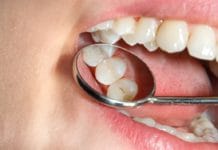Dental caries is a ubiquitous problem around the globe for people of all ages. Cavities not only cause discomfort, though. They also consume time and money. In the US, 92% of adults have experienced the pain and expense associated with dental cavities.
After years of scientific research demonstrated the effectiveness of fluoride in preventing dental decay, fluoride-fortified toothpaste hit the American market in 1956. While fluoride toothpaste has been the standard personal oral-hygiene product for over 60 years, questions linger regarding dose-dependent health, safety, and effectiveness.
Cochrane Reviews published a systematic review in March 2019 to determine how effectively fluoride prevents dental caries when fluoride concentrations in toothpaste vary. Ninety-six studies released between 1955 to 2014 were analyzed. The 96 studies included data from 65,335 dental patients (both children and adults) who brushed their teeth with toothpaste containing fluoride in concentrations ranging from 0 to 2400 parts per million fluoride (ppm F).
Background
The investigation into the effect of fluoride on dental health began in 1909 with Dr. Frederick McKay. After years of research, government officials began implementing the idea of using fluoride to improve dental health. Officials in Grand Rapids, MI were the first to add fluoride to the city’s drinking water in 1945.
In 1956, Proctor Gamble released the first fluoride-fortified toothpaste to hit the American market. Today, billions of people around the world rely on fluoride toothpaste as their first step in defending against cavities and dental decay. In the US, toothpastes typically include the fluoride compounds of sodium fluoride, sodium monofluorophosphate, or stannous fluoride.
Over 95% of toothpastes sold in the US contain fluoride. Typical over-the-counter toothpastes contain 1000 – 1500 parts per million of fluoride, although other concentrations are available. No minimum concentration level exists, but each country determines its own maximum-allowable fluoride concentration. High-concentration toothpastes typically require a prescription because of the potential for fluorosis. In the US, prescription-strength fluoride concentrations can contain 5000 ppm F.
Excessive fluoride intake can cause fluorosis in children whose teeth are still forming, especially under the age of 6. Fluorosis can cause pitting of the enamel and subsequent staining, although most cases result in mild symptoms. Children’s toothpaste containing lower concentrations of fluoride are available over the counter. While concentrations vary among manufacturers, some contain levels as low as 250 ppm F.
However, research shows that, even in children, brushing with concentrations under 550 ppm does not reduce the incidence of dental decay. Brushing with low-concentration fluoride toothpaste offers the same effects as brushing with non-fluoride toothpaste.
Results
Using a fluoride toothpaste is more effective in preventing dental decay than brushing with a non-fluoride toothpaste. In both children and adults, results indicated that brushing with a fluoride toothpaste reduced the incidence of new dental caries by approximately 24% when compared to brushing with non-fluoride toothpaste.
Higher concentrations of fluoride offer greater protection. In children and adolescents, brushing with 1450 to 1500 ppm F toothpaste reduced the amount of new decay more than using a 1000 to 1250 ppm F toothpaste, indicating that the higher concentrations are more effective.
Increasing the amount of fluoride even higher showed no extra benefits, however. When children brushed their teeth with either a 1700 to 2200 ppm or 2400 to 2800 ppm fluoride, the number of new carious lesions was similar to those who brushed with a 1450 to 1500 ppm toothpaste.
Final Notes
Encouraging patients to brush regularly with fluoride toothpaste should continue. This recent analysis improves upon past research by elucidating the potential benefits of higher-concentration fluoride toothpaste in preventing dental caries.










